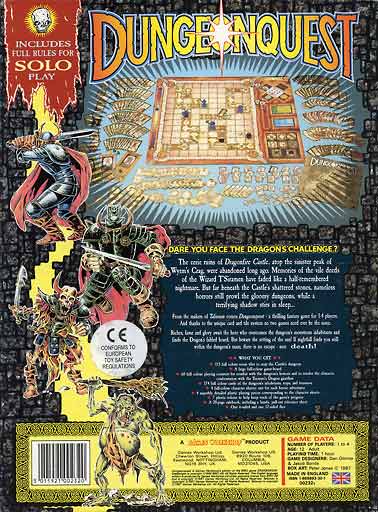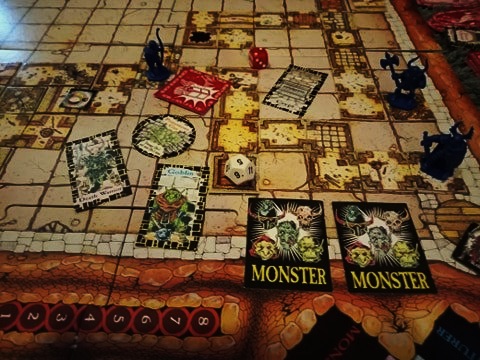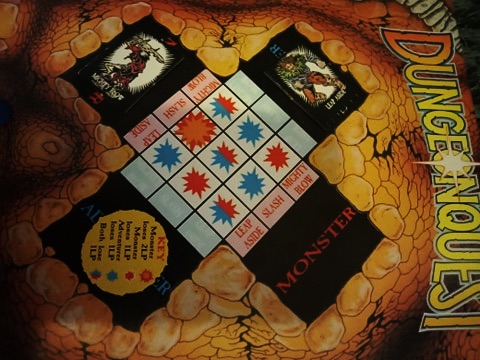Perhaps the most polarising of all decades, the 1980’s seemingly gifted us both the best and worst of all late-human culture as it shimmied seductively in spandex, with coiffed hair cresting the empathy-death ambition of cocaine dreams. It was also an interesting era for games, as the scene splintered and the offshoot roots of what would become hobby gaming plunged deep into the fecund untilled earth of ideas unplumbed.
Having once caught lightning in a crown-of-command-shaped-bottle and presumably having failed to set the world on fire with their 86 offering The Warlock of Firetop Mountain, the brave and bearded lads at Games Workshop returned to the drawing-board the following year to plot what would surely this time be the ultimate dungeon-delving experience that board and card could constrain.
Holed up in their Nottingham laboratory, they diligently plumbed the deepest recesses of their psyche for ideas, brain-stormed new mechanics and play-tested endless iterations on their formula until it shone like a perfect gemstone, refracting a light of pure fun through a prism of unfettered imagination.
Just kidding- they ripped off a Swedish game and put shoulder pads on it.
Designed by Dan Glimne and Jakob Bonds and unleashed upon their native Sweden in 1985, Drakborgen (Dragon Fortress) was the culmination of 5 years of development that saw their sinister offspring embraced by an umlaut-laden community hungry for tiny tiles and rampant death. Subsequently licensed by Games Workshop it was rebranded with added spikes for the 87 release that we in the English-speaking world now know and fear as DungeonQuest.

Since those hallowed days, the game has passed into the voluminous sleeves of Fantasy Flight Games who have released two further curations culminating in 2014’s Revised Edition that both sought to iterate and improve upon the humble yet strangely addictive framework laid down by the original.
In addition to this, Fandrake games recently presided over what became the most successful Swedish kickstarter of all time – offering a deluxe reprint of the original game, and are now gauging interest in a possible English translation complete with a hardback restrospective tome and the usual associated ephemera that washes up on the cash-lashed isle of Crowdfundia.
In short, this game suffers no shortage of acolytes and historical pedigree, so I simply had to see what all the fuss was about.
Did I pick up the enhanced and reasonably-priced modern edition? Did I bollocks. I craved the vaunted halls of history. I needed the flimsy cardstock, edge-worn box and crap components of the real deal. I wanted to pay waaaay too much for an ornamental artefact. It was my journalistic duty.
And lo it came to pass, arriving weather-beaten and pre-loved into my arms to taunt me with its hoard of riches, swathe of fatal traps and archaic combat mechanics. The original 87 iteration, sitting smugly as it winked at me, draped in linework art and period-charm.

Moments later, it was on the floor. A straightforward affair, this took mere minutes to learn and set-up, leaving any depth on offer to the emergent fun that resides in its infinite capacity to generate random scenarios to fuck with you. Unapologetic in its famed brutality, the box itself boasts that during playtesting it achieved on average a 15% survival rate amongst players. This is a decidedly old-school mentality, a relic from the days when player elimination was a badge of honour, as challenge was entwined with punishment like a gnarled oaken wand and with each rap of it upon their alabaster buttocks, players were instructed to reply in earnest: ‘Thank you sir, may I have another?’
Filling the leather boots of Fantasy Archetype Squad 347, players seek to infiltrate the infamous Castle Dragonfire and retrieve the hoard of legend that lies piled within. Spoken of only in reverent whispers, the Castle has claimed the lives of countless would be tomb-raiders and should the players fail to navigate its arcane walkways, retrieve the treasure and emerge before nightfall, then unutterable horrors are certain to befall them.
This conceit takes the form of a handy timer that successfully rachets up the pressure as the players tick off each turn in the knowledge that each step brings them closer to doom lest they be fleet of foot and brave of blade.

Drawing the random tiles that will form your passage through the halls of Castle Dragonfire is a strange delight, with no two games playing alike as the thoroughfares snake and twist, turning in upon themselves, winding into dead ends, perilous pits, poisonous clouds and the demonic denizens that may lurk behind every new tile. Far from being a deal-breaker, this air of randomness that permeates every step is in fact the game’s greatest asset as the tension of every move is amplified by the sheer ineffable nature of what purports to lay in waiting. There is precious little capacity for contingency as your dinky avatar is buffeted by the winds of fate, adrift in the sweeping chaos that unfurls as they draw from the selection of oddly shaped and paper-thin decks that layer sinew upon the labyrinth’s brittle bones.
Upon their meandering path, players will encounter rockslides, deadly darts, rotating rooms, secret doors, the bodies of fellow adventurers (ripe for the looting) and a selection of suitably Warhammer-esque foes that seek to pummel them into oblivion. Combat takes the form of another fumbling step towards today’s more refined fare and yet has idiosyncrasies all its own that experienced players can learn to exploit, subverting the agents of random chance in a style that speaks less of skill and more of the familiarisation that sits atop former follies. Upon unearthing each beast to be bested the player must declare if they will attack, flee or wait-and-see, with the player to their right cross referencing their decision with the monster card drawn to see whether the fiend will stand fast, strike first or high tail it out of there.
Should swords then be crossed- a simple rock, paper, scissors affair ensues as players select from the three possible actions of Strike, Leap Aside or Stunning Blow. The player to their right does likewise for the brute in question and they again reference a handy table that will indicate who has come off second best. Kingdom: Death Monster it ain’t, and though not exactly taxing it probably forms the biggest blemish on the brow of what has otherwise held up remarkably well as the intervening decades have marched on in fancy tailored trousers, flaunting their custom dice and tactical treatises.

At the heart of the labyrinth lies the hoard of plunder that has compelled us to tempt fate, and should players be fortunate enough to breach its inner sanctum, the game throws up yet another deliciously simple roadblock that again amplifies tension as players press their luck in the face of ever shortening odds.
For you see, astride this mountain of bounty lies the formidable form of a slumbering dragon with a famed predilection for roasting would-be thieves alive in their jerkins. Each turn spent here allows a fumbling hand to lucky dip into a bag of loot, unearthing two artefacts that will be tallied up in value to determine the games eventual victor, like some sinister spin on Antiques Roadshow by way of the Running Man. With each trembling fistful however, the players must select one of several facedown dragon tiles. All but one will see them silent enough to successfully misappropriate their spoils, but always lurking within is the one card that instantly invites them to the shittiest barbecue ever.
Do they bless the hand of providence and spin for home? Or risk another dip, increasing their potential lead as their avarice dances on a knife edge with doom? It’s incredibly tense, and a condensed Aesop-level exploration of sinful greed all-in-one. Like all elements on offer here, its simplicity belies its capacity for compulsion.

In each of our play-throughs this bastard dragon card emerged with a frequency bordering on the uncanny, leading us to believe that our copy was in fact cursed and possibly sourced from the pragmatic estate sale of some gone-to-soon Grognard, whose angry ghost wailed aghast as his collection was parcelled up and scattered to the winds, arriving in the undeserving paws of smart-arse reviewers on strange antipodean shores.
Eventually, after many an untimely demise, the attrition of fortune emerged and my weary warrior was able to escape this accursed place with a paltry sum in his coffers and a renewed sense of the virtue of poverty with which to regale his long suffering wife back in the village. As for the dragon? His hoard undimmed, he slumbered the sleep of the just, curled cosy upon coins in wait of the next foolhardy band of plunderers, set upon their perilous path by cackling sexagenarian Swedes.
Unlike so many other offerings of its age, DungeonQuest wears its antique vestments with a modicum of dignity that still possesses the power to beguile. Lean into its demands and you’ll surely appreciate the giddy highs, terrifying lows and shameful joy it continues to elicit.
 Games
Games How to resolve AdBlock issue?
How to resolve AdBlock issue? 























